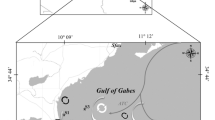Abstract
Changes in the autotrophic pico- (0.2–2 μm), nano- (2–20 μm), and microplankton (>20 μm) biomass (chlorophyll a) and primary production were measured in the estuarine and coastal waters off Cochin, southwest coast of India during the onset and establishment of a monsoon. During this period, the estuary was dominated by nutrient-rich freshwater, whereas the coastal waters were characterized with higher salinity values (>30 psu) and less nutrients. The average surface chlorophyll a concentrations and primary production rates were higher in the estuary (average 13.7 mg m − 3 and 432 mgC m − 3 day − 1) as compared to the coastal waters (5.3 mg m − 3 and 224 mgC m − 3 day − 1). The nanoplankton community formed the major fraction of chlorophyll a and primary production, both in the estuary (average 85 ± SD 8.3% and 81.2 ± SD 3.2%) and the coastal waters (average 73.2 ± SD 17.2% and 81.9 ± 15.7%). Nanoplankton had the maximum photosynthetic efficiency in the coastal waters (average 4.8 ± SD 3.9 mgC mgChl a m − 3 h − 1), whereas in the estuary, the microplankton had higher photosynthetic efficiency (average 7.4 ± 7 mgC mgChl a m − 3 h − 1). The heavy cloud cover and increased water column turbidity not only limit the growth of large-sized phytoplankton in the Cochin estuary and coastal waters but also support the proliferation of nanoplankton community during the monsoon season, even though large variation in nanoplankton chlorophyll a and production exists between these two areas.
Similar content being viewed by others
References
Agawin, N. S. R., Duarte, C. M., & Agustı, S. (2000). Nutrient and temperature control of the contribution of picoplankton to phytoplankton biomass and production. Limnology and Oceanography, 45(3), 591–600.
Armstrong, R. A. (1994). Grazing limitation and nutrient limitation in marine ecosystems: steady state solutions of an ecosystem model with multiple food chains. Limnology and Oceanography, 39, 597–608.
Cermeno, P., Maranon, E., Rodrıguez, J., & Fernandez, E. (2005). Large-sized phytoplankton sustain higher carbon-specific photosynthesis than smaller cells in a coastal eutrophic ecosystem. Marine Ecology Progress Series, 297, 51–60. doi:10.3354/meps297051.
Cermeno, P., Maranon, E., Perez, V., Serret, P., Fernandez, E., & Castr, C. G. (2006). Phytoplankton size structure and primary production in highly dynamic coastal ecosystem (Ria de Vigo, NW-Spain): Seasonal and short-time scale variability. Estuarine, Coastal and Shelf Science, 67, 251–266. doi:10.1016/j.ecss.2005.11.027.
Chisholm, S. W. (1992). Phytoplankton size. In: P. G. Falkowski and A. D. Woodhead (Eds.), Primary productivity and biogeochemical cycles in the sea (pp. 213–236). New York: Plenum.
Glover, H. E., Phinney, D. A., & Yentsch, C. S. (1985). Photosynthetic characteristics of picoplankton compared with those of larger phytoplankton populations, in various water masses in the Gulf of Maine. Biological Oceanography, 3, 223–248.
Grasshoff, K. (1983). Methods of seawater analysis. In: K. Grasshoff, M. Ehrhardt, & K. Kremling (Eds.), (2nd ed., p 419). Weinheim: Verlag Chemie.
Jyothibabu, R., Madhu, N. V., Jayalakshmi, K. V., Balachandran, K. K., Shiyas, C. A., Martin, G. D., et al. (2006). Impact of fresh water influx on microzooplankton mediated food web in a tropical estuary (Cochin backwaters—India). Estuarine, Coastal and Shelf Science, 69, 505–518. doi:10.1016/j.ecss.2006.05.013.
Legendre, L., & Le Fevre, J. (1988). Hydrodynamic singularities as controls of recycled versus export production in oceans. In: W. H. Berger, V. S. Smetacek, & G. Wefer (Eds.), Productivity of the ocean: Present and past, Dahlem Konferenzen. Chichester: Wiley.
Madhu, N. V., Jyothibabu, R., Balachandran, K. K., Honey, U. K., Martin, G. D., Vijay, J. G., et al. (2007). Monsoonal impact on planktonic standing stock and abundance in a tropical estuary (Cochin Backwaters—India). Estuarine, Coastal and Shelf Science, 73, 54–64. doi:10.1016/j.ecss.2006.12.009.
Malone, T. C. (1980). Algal size. In: I. Morris (Ed.), The physiological ecology of phytoplankton (pp. 433–465). London: Blackwell Scientific.
Menon, N. N., Balchand, A. N., & Menon, N. R. (2000). Hydrobiology of the Cochin backwater system—a review. Hydrobiologia, 430, 149–183. doi:10.1023/A:1004033400255.
Qasim, S. Z. (1974). Contribution of microplankton & nanoplankton in the waters of a tropical estuary. Indian Journal of Marine Sciences, 3, 146–149.
Qasim, S. Z. (2003). Indian estuaries (259 pp). Mumbai: Allied.
Raimbault, P., Rodier, M., & Taupier-Letage, I. (1988). Size fraction of phytoplankton in the Ligurian Sea and the Algenan Basin (Mediterranean Sea): size distribution versus total concentration. Marine Microbial Food Webs, 3, 1–7.
Riegman, R., Kuipers, B. R., Noordeloos, A. A. M., & Witte, H. J. (1993). Size-differential control of phytoplankton and the structure of plankton communities. Netherlands Journal of Sea Research, 31, 255–265. doi:10.1016/0077-7579(93)90026-O.
Shiomoto, A. (1997). Size fractionated chlorophyll a concentration and primary production in the Okhotsk Sea in October and November 1993, with special reference to the influence of Dichothermal water. Journal of Oceanography, 53, 601–610.
Tang, E. P. Y. (1995). The allometry of algal growth rates. Journal of Plankton Research, 17, 1325–1335. doi:10.1093/plankt/17.6.1325.
Taylor, A. H., Geider, R. J., & Gilbert, F. J. H. (1997). Seasonal and latitudinal dependencies of phytoplankton carbon-to-chlorophyll a ratios: results of a modelling study. Marine Ecology Progress Series, 152, 51–66. doi:10.3354/meps152051.
UNESCO (1994). Protocols for the Joint Global Ocean Flux Study (Vol. 29, p. 190). Manual & Guides.
Author information
Authors and Affiliations
Corresponding author
Rights and permissions
About this article
Cite this article
Madhu, N.V., Jyothibabu, R. & Balachandran, K.K. Monsoon-induced changes in the size-fractionated phytoplankton biomass and production rate in the estuarine and coastal waters of southwest coast of India. Environ Monit Assess 166, 521–528 (2010). https://doi.org/10.1007/s10661-009-1020-8
Received:
Accepted:
Published:
Issue Date:
DOI: https://doi.org/10.1007/s10661-009-1020-8




